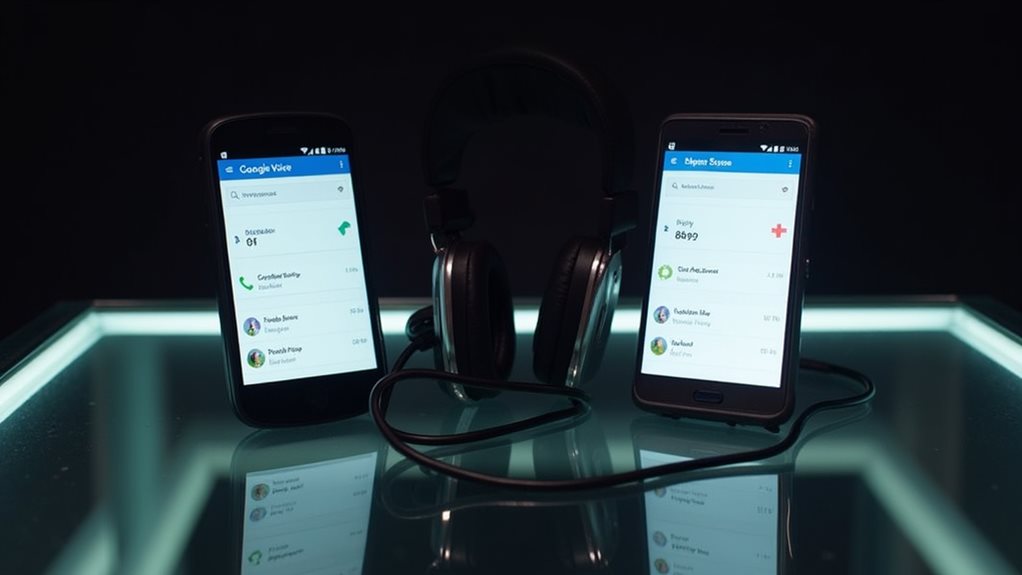Your choice between Google Voice and OpenPhone depends on your specific needs. Google Voice works best for personal use and basic business requirements, offering free service and seamless Google integration. OpenPhone, while pricier, delivers advanced features like team collaboration tools, CRM integration, and dedicated business support. Consider your priorities: if you need basic calling and texting, go with Google Voice; for growing teams and professional features, OpenPhone's your better bet. Let's explore how each platform stacks up in detail.
Core Features Comparison
When comparing Google Voice and OpenPhone, understanding their core features helps you make an informed decision for your communication needs.
Through a detailed feature comparison, you'll discover that both platforms offer distinct advantages for managing your business communications. OpenPhone excels in providing a modern user experience with team collaboration tools, while Google Voice integrates seamlessly with other Google services you're likely already using.
Your choice between these platforms often depends on your specific requirements. Google Voice offers reliable call forwarding and voicemail transcription, which you'll find familiar if you're in the Google ecosystem. Moreover, Google Voice features unlimited texts that eliminate extra charges, making it a cost-effective option for many users.
Meanwhile, OpenPhone stands out with its business-focused features like shared phone numbers and advanced analytics. Both services provide mobile apps, but their approaches to functionality and interface design differ substantially.
Pricing Plans and Value Analysis
Understanding the pricing structure between Google Voice and OpenPhone reveals significant differences in their value propositions. When you're conducting a pricing comparison between these services, you'll find that each platform offers distinct advantages for different types of users.
Your value assessment should consider both immediate costs and long-term benefits for your communication needs.
- Google Voice provides a free tier for personal use, making it instantly appealing for budget-conscious individuals.
- OpenPhone's professional features justify its premium pricing for business users.
- You'll get more advanced analytics and CRM integrations with OpenPhone's higher tiers.
- Google Voice's integration with Google Workspace creates a seamless experience that might offset its business plan costs. Additionally, VoIP technology typically offers better call quality compared to traditional systems, which can enhance overall communication for businesses.
Call Quality and Reliability

The two critical factors in any VoIP service evaluation are call quality and connection reliability. When you're choosing between Google Voice and OpenPhone, you'll want to guarantee crystal-clear communications for your professional needs.
Both services offer HD voice capabilities, but you'll notice some differences in real-world performance. Google Voice tends to maintain consistent call clarity across various network conditions, leveraging Google's robust infrastructure. However, you might experience occasional connectivity issues during peak usage times.
OpenPhone, while newer to the market, has invested heavily in their voice quality technology and generally provides stable connections. You'll find that both services perform well on stable internet connections, though OpenPhone seems to handle weak signals slightly better. Network latency can also impact your experience, emphasizing the importance of a reliable internet connection.
Your specific location and internet stability will ultimately impact your experience with either service.
Team Collaboration Capabilities
When comparing team collaboration features, you'll find OpenPhone offers more robust shared inbox capabilities that let your team seamlessly manage conversations and client interactions together. Google Voice's group messaging works for basic team communication but lacks the extensive collaboration tools that modern businesses need. OpenPhone's real-time team features, including message comments and internal notes, make it easier for your staff to coordinate responses and share important information without switching between multiple platforms. Additionally, OpenPhone's integration capabilities with advanced features enhance overall team productivity and streamline communication workflows.
Shared Team Inbox Features
Modern teams need robust collaboration tools, and both Google Voice and OpenPhone approach shared inbox features differently.
When you're evaluating shared inbox advantages, you'll find that these platforms offer distinct ways to manage team communications. Your team's ability to coordinate and respond efficiently depends on understanding shared inbox challenges and choosing the right solution.
- You'll notice OpenPhone's shared inbox puts team context front and center, making it easier to stay aligned with colleagues.
- Google Voice's approach may feel more familiar if you're already using Google Workspace.
- Your team can benefit from OpenPhone's real-time collaboration features.
- You'll appreciate how both platforms help reduce communication gaps.
The key differences in shared inbox functionality will impact how your team handles customer conversations and internal coordination.
Group Messaging Functionality
Effective group messaging can make or break your team's ability to collaborate seamlessly. When comparing Google Voice and OpenPhone's group messaging benefits, you'll find distinct differences in how each platform handles team communication.
OpenPhone offers robust group messaging capabilities that let you create dedicated channels for different projects or departments, making it easier to keep conversations organized.
You'll appreciate the ability to share files, tag team members, and track message history. However, there are group messaging limitations to take into account.
Google Voice's group messaging features are more basic, primarily focused on SMS group texts rather than internal team collaboration. While it's serviceable for simple group communications, you might find yourself needing additional tools to supplement its functionality if your team requires more sophisticated collaboration features. Additionally, VoIP applications like RingCentral provide collaboration tools integrated into their platforms to enhance teamwork and productivity.
Real-Time Team Communications
Real-time team collaboration serves as the backbone of today's virtual workspace environment. When choosing between Google Voice and OpenPhone, you'll want to evaluate their team communication capabilities carefully. Both platforms offer instant notifications and real-time feedback features that keep your team connected and responsive.
- OpenPhone enhances team dynamics with shared inboxes that let you see who's handling which conversations.
- Google Voice provides seamless integration with other Google Workspace tools for unified communication.
- OpenPhone's comment system allows internal team discussions without leaving the platform.
- Google Voice delivers reliable message synchronization across all team members' devices.
Additionally, VoIP enhances communication efficiency with its advanced features, making it a valuable tool for both platforms in optimizing team collaboration.
You'll find that while both solutions support collaborative communication, your choice should align with your team's existing workflow and the level of real-time interaction you need for daily operations.
Mobile App Experience
The mobile app experience plays an essential role in determining which business phone service will best suit your needs. When you're comparing Google Voice and OpenPhone's app usability, you'll want to reflect on how seamlessly you can manage your business communications on the go.
Both platforms offer mobile apps, but user feedback suggests varying experiences with each service. You'll find that both apps provide essential calling and messaging features, though they differ in their interface design and navigation.
While Google Voice integrates naturally with other Google services you might already use, OpenPhone focuses on delivering a more business-specific experience. Ponder how often you'll need to switch between different features and how important quick access to advanced functions is for your daily workflow.
The app you choose should align with your team's mobile communication patterns.
International Calling Options

When you're looking at international calling features, Google Voice and OpenPhone both offer competitive global rates, though you'll find Google Voice tends to be slightly cheaper for most destinations. OpenPhone provides international numbers in more countries, letting you establish a local presence across multiple regions if that's important for your business. You'll need to weigh whether Google Voice's lower per-minute rates or OpenPhone's broader international number availability better matches your specific global communication needs. Additionally, Google Voice's integration with tools like Google Calendar can enhance your overall communication strategy.
Global Rates Comparison
Both platforms offer international calling capabilities, though they differ markedly in their pricing structures and global coverage.
When you're exploring international calling options, you'll find that their global reach and regional pricing models can greatly impact your communication costs. Understanding these differences will help you make an informed choice that aligns with your needs.
- OpenPhone's flat-rate pricing to many countries helps you predict your monthly expenses.
- Google Voice's pay-as-you-go model gives you flexibility for occasional international calls.
- You'll appreciate OpenPhone's transparent pricing structure in key business regions.
- Google Voice's established global network offers broader country coverage.
- For cost-effective international calling, platforms like Ooma provide competitive rates that can lead to significant savings.
Remember that rates can fluctuate based on your destination country and calling frequency.
If you're frequently connecting with international contacts, you'll want to carefully compare each platform's specific rates for your most-called destinations.
International Number Availability
Considering international business expansion, you'll find notable differences between Google Voice and OpenPhone's international number availability.
When following international number trends, you'll notice that OpenPhone provides local numbers in the US and Canada, while Google Voice offers broader coverage across multiple countries.
Global number regulations vary by region, and both services must comply with local telecommunications laws.
You'll discover that Google Voice lets you make calls to over 50 countries, giving you flexibility in reaching international contacts.
OpenPhone's international coverage is more limited but focuses on providing reliable service in North America.
For your global communication needs, it's crucial to evaluate which platform aligns with your target markets and business locations.
Consider where most of your international contacts are based before making your choice. Additionally, the significant cost savings of VoIP services make it a compelling option for businesses looking to expand internationally.
Customer Support and Service
Getting reliable customer support can make or break your experience with any communication service. When analyzing customer satisfaction metrics and support responsiveness evaluation between Google Voice and OpenPhone, you'll find notable differences in how each platform handles user concerns.
- Google Voice relies primarily on self-help resources and community forums, which can leave you feeling disconnected when facing urgent issues.
- OpenPhone's dedicated support team responds within hours, not days, giving you peace of mind.
- You'll join a more personalized support experience with OpenPhone's one-on-one assistance.
- Google's automated systems often require multiple steps before reaching human support, causing frustration.
Additionally, VoIP enhances customer service through advanced communication features, which can be critical in delivering quality support.
Both services continuously work to improve their support systems, but if you're looking for direct human interaction and faster resolution times, you'll likely feel more supported with OpenPhone's customer service approach.
Business Integration Tools

When you're choosing between Google Voice and OpenPhone for your business, their integration capabilities with essential tools can make a significant difference in your workflow.
You'll find OpenPhone offers robust CRM system compatibility and calendar app integration, allowing you to sync customer data and schedule meetings seamlessly across platforms.
Google Voice, while more limited in third-party integrations, provides native integration with Google Workspace tools and offers basic team management features that might be sufficient for smaller organizations.
CRM System Compatibility
Both Google Voice and OpenPhone differ markedly in their ability to integrate with customer relationship management (CRM) systems.
You'll find that OpenPhone offers more robust crm tools and integration options, making it easier to sync your business communications with popular platforms like Salesforce and HubSpot.
Meanwhile, Google Voice's CRM compatibility remains more limited, though it works well within the Google Workspace ecosystem.
- OpenPhone's native Salesforce integration helps you track client interactions seamlessly
- Google Voice's HubSpot connection requires third-party workarounds
- You'll maintain better client relationships with OpenPhone's automated contact syncing
- Your team can access thorough customer histories through OpenPhone's CRM tools
When you're choosing between these services, consider how your existing CRM infrastructure aligns with each platform's capabilities.
The right integration can meaningfully streamline your workflow and improve customer engagement.
Calendar App Integration
The integration capabilities with calendar apps showcase notable differences between Google Voice and OpenPhone's business tools.
When you're managing multiple appointments and calls, you'll find that Google Voice seamlessly connects with Google Calendar, making it easier to track your communication timeline and schedule. The calendar syncing feature automatically updates your availability based on your meetings and calls.
OpenPhone takes a different approach by offering calendar integration through third-party connections. While you'll get appointment reminders and scheduling options, you might need to set up additional tools to achieve the same level of integration that Google Voice provides natively.
However, OpenPhone's flexibility means you can connect with various calendar platforms, giving you more choices if you're not exclusively using Google's ecosystem.
Team Management Features
Since managing a business team requires robust communication tools, you'll find significant differences in how Google Voice and OpenPhone handle collaborative features.
OpenPhone excels at team dynamics with dedicated workspaces, while Google Voice offers more basic sharing options. Both platforms understand your need to keep your team connected and productive.
- OpenPhone's shared inbox lets your team seamlessly collaborate on customer conversations, building stronger client relationships.
- Google Voice's admin controls help you maintain professional standards across your organization.
- OpenPhone's performance tracking tools give you insights into team communication patterns.
- Google Voice's integration with Workspace makes team coordination feel natural and familiar.
When choosing between these platforms, consider how their collaborative features align with your team's communication style and workflow requirements.
Your team's efficiency depends on selecting tools that foster seamless cooperation.
Security and Privacy Measures

Protecting your communication remains a critical consideration when choosing between Google Voice and OpenPhone. Both platforms offer encryption protocols to safeguard your calls and messages, but you'll find some notable differences in their security implementations.
Google Voice leverages Google's robust security infrastructure, while OpenPhone provides its own set of privacy measures.
You'll appreciate Google Voice's integration with Google's extensive privacy policies and two-factor authentication options.
OpenPhone, meanwhile, focuses on business-grade security features, including end-to-end encryption for messages and customizable privacy settings.
When you're handling sensitive client information or personal communications, it's worth noting that both services comply with industry standards for data protection.
Your choice might depend on whether you prefer Google's established security ecosystem or OpenPhone's business-focused privacy controls.
User Interface and Setup Process
Setting up your preferred communication system can greatly impact your daily workflow and user experience. When comparing Google Voice and Openphone, you'll find distinct differences in their setup tutorials and interface designs.
Both platforms aim to streamline your communication needs, but they approach user experience differently.
- You'll feel more confident with Google Voice's familiar interface if you're already using other Google products.
- You'll experience a sense of accomplishment with Openphone's guided setup process.
- You'll appreciate Google Voice's straightforward dashboard that connects seamlessly with Gmail.
- You'll enjoy Openphone's modern, intuitive design that makes you feel like a professional.
Each platform offers unique features during setup, and your choice may depend on whether you prefer Google's integrated ecosystem or Openphone's standalone approach.
Consider which interface aligns better with your team's communication style and workflow preferences.
Frequently Asked Questions
Can You Port Existing Phone Numbers From Other Carriers to These Services?
You'll be glad to know both services offer number portability options! You can transfer your existing number through their carrier transfer process. Just follow their step-by-step guides, and you'll keep your familiar digits.
What Happens to Your Data if You Cancel Either Service?
You'll want to know that both services have different data retention policies. When you cancel, OpenPhone deletes your data after 30 days, while Google Voice lets you download your data before canceling your service.
Do Google Voice or Openphone Work in Countries With Internet Restrictions?
You'll face challenges using either service in restricted countries. Your internet access may be blocked by local firewalls, affecting service reliability. Consider using a VPN, but be aware of local regulations first.
Can You Schedule Text Messages to Be Sent Later?
You'll love the scheduled messaging features on both platforms! OpenPhone lets you easily set up text message automation for future sending, while Google Voice doesn't currently offer scheduling—you'll need to send messages right away.
Are There Limits on How Many Voicemail Messages You Can Store?
You'll have plenty of space for voicemail storage with both services. OpenPhone offers unlimited message retrieval, while Google Voice gives you generous storage that'll rarely need clearing. You're covered either way for voicemails!
Final Thoughts
Your choice between Google Voice and OpenPhone should depend on your specific needs. If you're looking for a basic, cost-effective solution for personal use, Google Voice's free plan might be your best bet. However, if you need robust business features, team collaboration tools, and advanced integrations, OpenPhone's extensive platform justifies its higher price point. Consider your budget, team size, and required features before making your final decision.

